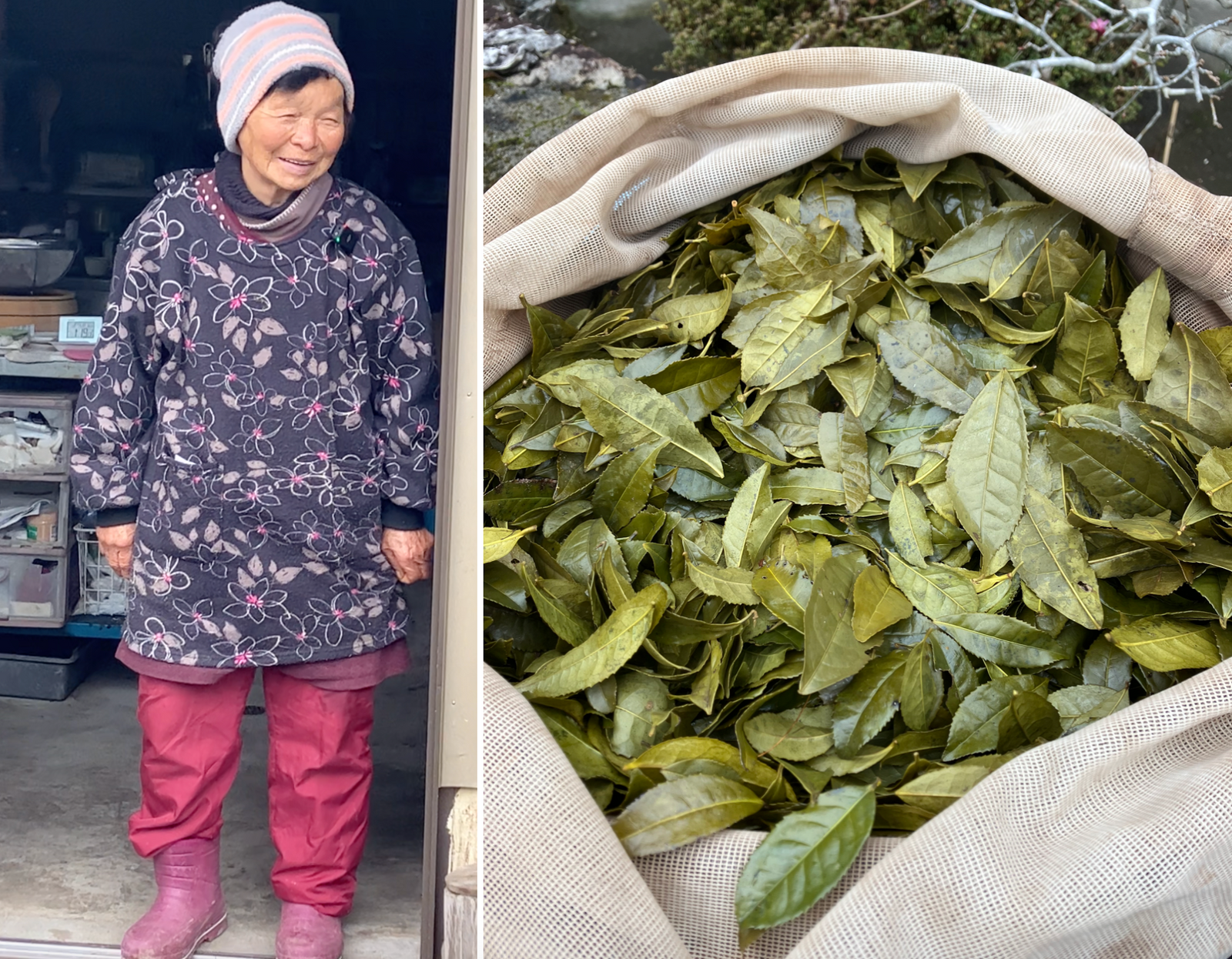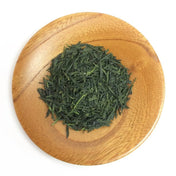On February 3-4, we visited Akemi Ishimoto, an 87 year old kancha tea farmer who is located in the Southernmost tip of Tokushima Prefecture. You can learn about the kancha making process in a recent article (How Shishikui kancha is made). Here we will expand on Akemi-san and weave together both information that we learned on our trip with information gathered from subsequent research.
"Kancha baachan"
Akemi-san resides in Kuo village, a small mountain village that is a part of the greater Shishikuicho, Kaiyo town (located on the border between Tokushima and Kochi Prefecture. Kaiyo town is known for its ocean, surfing, and other marine-related recreational activities. Kuo village is located about a 30 minute ride, up and down narrow mountain roads (mostly one lane once you get further into the mountains), around relatively tight corners, and the drive is mainly along the None River.
Just by interacting with Akemi-san over two days, we could clearly see she was passionate about her kancha. She mentioned that she has never met anyone else who likes kancha more than herself. That is why villagers and people in this region affectionately refer to her as “kancha baachan” (which roughly translates to, granny kancha).
We also clearly saw that she has been working hard her entire life. As we sat by her when she was boiling the kancha leaves after they had been harvested, she commented that the kancha season keeps her quite busy but that even when she is not hard at work with her tea, there are other tasks to do like weeding, rice planting and harvesting, and other farm chores, not to mention those related to caring for her husband, keeping the house and raising children. With a smile, she shared that many of her friends tease her because she is never resting and always keeping busy (I got an image of her as a wise hummingbird).

Akemi-san was born in Kuo village, Tokushima Prefecture. When she was 19 years old and studying dressmaking, she married a man who was doing forestry, whom her parents had arranged for her to marry. They had two children. She has mentioned previously that, “It was not the life she would have willingly sought herself”. Interestingly, Akemi-san also shared that she used to be responsible for managing the “dojo” of the village. We were able to look inside the dojo and it was still very nice and neatly organized. The building has white walls and on one side of the wall, there are lyrics to songs written on the walls. From my understanding, it is the song of the seasons of Kuo village and None river. We asked Akemi-san to sing her village song but she was too embarrassed to sing in front of a group.


Some time after marrying and raising her children, a tide of depopulation began to overtake Kuo village. Akemi-san kept wondering whether she could do some new work in the place where she grew up. That is when she realized that she wanted to produce and sell the wild tea that grew in the terraces behind her home. This was a new beginning for Akemi-san. She cultivated the soil behind her house and sowed more wild tea seeds. With the help from the members of the Kancha Production Association (which we will touch on subsequently), Akemi-san succeeded in commercializing kancha at the age of 53.
Kancha had been around in this region a while before Akemi-san became a tea farmer. There are various types of bancha produced in different parts of Japan. However, those belonging to the kamamairicha lineage (which was imported from China) are tea production methods that spread rapidly in the early modern period, and its origins cannot be traced back before the Edo period (year 1603). On the other hand, the technique of producing tea that can be preserved through simple processes such as steaming, boiling, and drying (and is able to be stored/preserved), is considered to be quite old. These techniques have the possibility of dating back to before the Middle Ages. And these types of banchas can be found all over Shikoku Island!

Shikoku Tea Map, courtesy of Josh Linvers (sommerier.com).
The Kancha Production Association
Akemi Ishimoto founded the Kancha Production Association (Japanese: 寒茶生産組合) in 1986. Even before the production of kancha, the women in Kuo village had been proactive. In the year 1972, 14 women got together to establish the Lifestyle Improvement Group. Since then, research has been actively conducted in Kuo village on the processing of wild vegetables that are prepared in each household, taking advantage of the geographical location of their mountain village.
Later on in 1986, the movement to make kancha a specialty product in the Shishikui area became full-fledged, and that was when the Kancha Production Association was formed. This movement was spearheaded by Akemi-san and at the beginning, the association consisted of 20 farmers. Moreover, approximately 30 women from seven surrounding districts, including neighboring areas Hisao and Funatsu, worked together to create a product to sell as the specialty of this region (hence, its name Shishikui kancha).
Due to the fact that manufacturing methods differed across households, the members got together to settle on a standard recipe for their kancha. It took them three years of trial and error to determine the steaming time, the amount of hand kneading, and the drying method, until everyone could produce the same quality kancha. Consequently, the Shishikui kancha gained many fans both inside and outside the prefecture, including Tokushima City, Osaka, and in Mie Prefecture.
Kancha was commercialized through the Kaifu Agricultural Cooperative and other outlets. They cultivated the tea, processed, and sold it. In order to avoid wasting it, they also sold kancha in tea bags and bottles. Yet, as the members continued to age, the association saw a gradual decline with respect to the number of members and the villages it represented.
The women in the Kancha Production Association often contributed their good health to kancha drinking. Perhaps, kancha was a contributing factor but my guess is that it was their activities that kept them healthy and young (e.g., social support, being (physically) active together during the kancha season). A benefit of kancha was that it was delicious boiled, and even if it cooled down, in the winter time it did not go bad for 10 days. The flavor and aroma did not change during this time. Other members also have mentioned how their favorite way of drinking kancha was actually cold-brewed for the warmer summer months.
Biodiversity of Kuo village
To provide a bit more detail with respect to the context of Akemi-san’s kancha, Kuo village is located in a slightly open valley deep in the mountains. Here, rice cultivation is said to have begun 300 years ago. Even today, actively cultivated rice terraces can be seen, making their presence clear between the mountains. In fact, the stone terraces that we saw at Akemi-san’s house are neatly arranged and stable. Given the sturdiness of the stonewalls, it has surely been repaired by many skilled hands over the years.

The river that runs in this village is the None river, home to natural sweetfish and Japanese native trout called amego. It is a graceful clear stream, and one of the few without a dam. Akemi-san’s house and tea fields are located across the bridge (over the river) and as we were crossing the bridge, we heard many hawk calls and saw them circling around up above. In the summer, fireflies will show their beautiful display and there are also the dragonflies, to name just a few of the species in this area. In the mountains, there is the usual wildlife that one comes across in the inaka (rural Japan): wild boars, deer, Japanese serow (a type of mountain goat), raccoons, and monkeys (I spotted three monkeys on the route to Kuo). And of course, one cannot forget the wild mice that help to plant the tea seeds! The biodiversity of this region as well as the clear mountain water are contributing factors to Akemi-san’s delicious kancha.

Active Senior Certified Village of 2021
Prior to Akemi-san and her farmer friend’s efforts in the 1980’s to make kancha a commercial product, the people in Kuo village were mainly growing rice like most other villages in Japan. Currently, Kuo is famous for the production of kancha. Akemi-san provides hands-on learning experiences, mainly for the children in this region. She is well known enough amongst certain circles that tea aficionados will also visit her occasionally, and she has also gotten quite a bit of Japanese media attention (e.g., NHK, Asahi Shinbun). Unfortunately, as of now, Akemi-san is the last person making Shishikui kancha and there is no successor for this unique and delicious regional bancha. Due to depopulation, Kuo village currently has a population of about 10 and most of those residents are well over the age of 70. There is thus a high possibility that the beautiful mountain tea fields will become abandoned in the near future.
Despite the seemingly inevitable decline of Kuo villsge, Akemi-san and the Kancha Production Association have helped to shine light on this small mountain village. In depopulated and aging areas of Tokushima Prefecture, villages where elderly people actively and independently participate in a variety of local activities and contribute to regional revitalization are recognized as model cases so that other regions may be inspired and/or learn from them. Called, “Active Senior Certified Villages'' (Japanese: アクティブシニア集落), Kuo village was recognized as one of the Active Senior Certified Villages in the year 2021 thanks to the efforts of Akemi-san and the Kancha Production Association members.
That year, when Akemi-san attended the award ceremony to receive the recognition for Kuo village, she commented,
“With no future in sight, I have been working hard for the sake of the community and encouraging myself. My involvement and activities in agriculture and making processed agricultural products have led to income. And for this reason, I am able to live in Kuo village. I did this wholeheartedly. Thanks to this, I was able to connect with many different people. I also gained a lot of knowledge. Now, there aren’t many people around, and even though I don't have much physical strength, I've still managed to do my best. ”
And when asked what was so rewarding about her work, Akemi-san replied while smiling,
“Well, it depends on the season, but at the moment, I am producing kancha. At the nearby processing factory I also make miso, sweets, and pickled vegetables. In addition, I make sushi and mochi to bring to the market but only on Sundays. At the processing factory, we do this together, the four of us. We are all 70 ~ 80 year old Kuo villagers. Without this, I would be quite lonely. This is what I find most rewarding.”
In fact, when we visited Akemi-san during the kancha season, I accidentally walked into the processing factory as she was preparing her sushi and mochi with one other villager on Saturday evening. The sushi they were preparing was going to be brought to the Sunday morning market.

Akemi-san kindly treated us to her delicious sushi (made with yuzu vinegar) and mochi snacks that Sunday and the combination of the meal with her kancha was simply perfect. Plus, we had a wonderful view of her tea fields! Witnessing Akemi-san make her kancha and talk about her love of this winter bancha was inspiring.
Thank you, Akemi-san! We are deeply grateful we had the opportunity to visit her in person.
Have additional insights? Please don't hesitate to post comments and/or questions below. Or directly contact me (Moé Kishida): moe@yunomi.life. Thank you!


